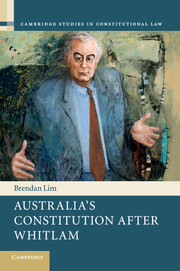6 - The Howard Referendum
Published online by Cambridge University Press: 06 April 2017
Summary
Whitlam's speech immediately after Sir David Smith proclaimed the dissolution of the Parliament on 11 November 1975 is among the most famous in Australian political history. ‘Well may we say, ‘God save the Queen’’, Whitlam pronounced, before pausing for effect, ‘because nothing will save the Governor-General.’ Whitlam would later enlist these words in service of his considered argument for an Australian republic, but at the time he remained a monarchist. He believed that any ‘rage’ in 1975 was properly directed not against the system of constitutional monarchy, but against Kerr and even more so against Fraser, both of whom, in Whitlam's view, had acted outside of the system. At a press conference later in the day, Whitlam was asked whether the events would ‘result in a move towards republicanism in Australia’, but he refused to speculate: ‘I'm too far committed to the monarchy as you know … the Queen would never have done this, let's be frank about this. The Queen would never have done this.’
Nearly 25 years later, on 6 November 1999, the Australian people reje- cted a proposed alteration of the Constitution ‘to establish the Common- wealth of Australia as a republic’. It may seem a surprising result that a mature, independent nation on the cusp of the twenty-first century could choose monarchy. It may seem all the more surprising in the light of the extraordinary vice-regal intervention in 1975. Authentic support for constitutional monarchy, whether as an affirmative commitment or a negative aversion to change, should not be underestimated.But that was not the only reason, and not even the primary reason, why the referendum foundered. Many explanationsfor the result have been posited since 1999, but it is widely recognised that the republican vote was split between those who supported parliamentary appoint- ment of the President and those who supported direct election. Direct election republicans campaigned against the referendum. This split manifested the two opposing conceptions of the Australian people that had been left unresolved in the wake of 1975: is the people's sovereignty to be mediated through Parliament, or can it be expressed directly through other institutions?
- Type
- Chapter
- Information
- Australia's Constitution after Whitlam , pp. 194 - 231Publisher: Cambridge University PressPrint publication year: 2017

